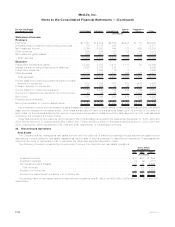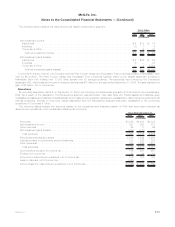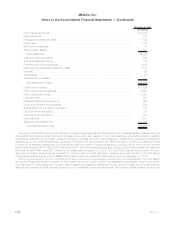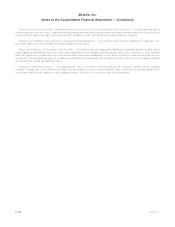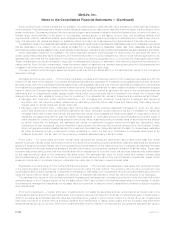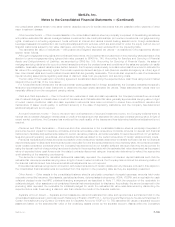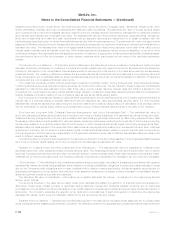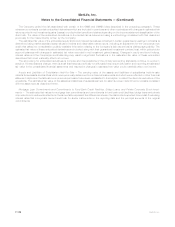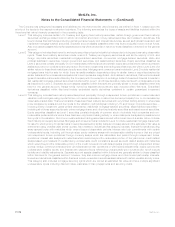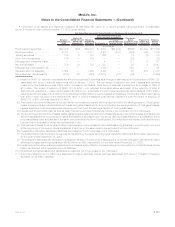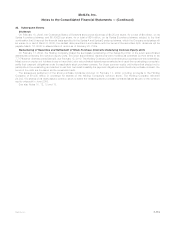MetLife 2008 Annual Report Download - page 229
Download and view the complete annual report
Please find page 229 of the 2008 MetLife annual report below. You can navigate through the pages in the report by either clicking on the pages listed below, or by using the keyword search tool below to find specific information within the annual report.separate accounts include: mutual funds, fixed maturity securities, equity securities, mortgage loans, derivatives, hedge funds, other
limited partnership interests, short-term investments and cash and cash equivalents. The estimated fair value of mutual funds is based
upon quoted prices or reported net assets values provided by the fund manager and are reviewed by management to determine whether
such values require adjustment to represent exit value. The estimated fair values of fixed maturity securities, equity securities, derivatives,
short-term investments and cash and cash equivalents held by separate accounts are determined on a basis consistent with the
methodologies described herein for similar financial instruments held within the general account. The estimated fair value of hedge funds is
based upon NAVs provided by the fund manager and are reviewed by management to determine whether such values require adjustment to
represent exit value. The estimated fair value of mortgage loans is determined by discounting expected future cash flows, using current
interest rates for similar loans with similar credit risk. Other limited partnership interests are valued giving consideration to the value of the
underlying holdings of the partnerships and by applying a premium or discount, if appropriate, for factors such as liquidity, bid/ask spreads,
the performance record of the fund manager or other relevant variables which may impact the exit value of the particular partnership
interest.
Policyholder Account Balances — Policyholder account balances in the table above include investment contracts and customer bank
deposits. Embedded derivatives on investment contracts and certain variable annuity riders accounted for as embedded derivatives are
included in this caption in the consolidated financial statements but excluded from this caption in the table above as they are separately
presented therein. The remaining difference between the amounts reflected as policyholder account balances in the preceding table and
those recognized in the consolidated balance sheet represents those amounts due under contracts that satisfy the definition of insurance
contracts and are not considered financial instruments.
The investment contracts primarily include guaranteed investment contracts, certain funding arrangements, fixed deferred annuities,
modified guaranteed annuities, fixed term payout annuities, and total control accounts. The fair values for these investment contracts are
estimated by discounting best estimate future cash flows using current market risk-free interest rates and adding a spread for the
Company’s own credit determined using market standard swap valuation models and observable market inputs that take into consideration
publicly available information relating to the Company’s debt as well as its claims paying ability.
Due to frequency of interest rate resets on customer bank deposits held in money market accounts, the Company believes that there is
minimal risk of a material change in interest rates such that the estimated fair value approximates carrying value. For time deposits,
estimated fair values are estimated by discounting the expected cash flows to maturity using a discount rate based on an average market
rate for certificates of deposit being offered by a representative group of large financial institutions as of the date of the valuation.
Short-term and Long-term Debt, Collateral Financing Arrangements, and Junior Subordinated Debt — The estimated fair value for
short-term debt approximates carrying value due to the short-term nature of these obligations. The estimated fair values of long-term debt,
collateral financing arrangements, and junior subordinated debt securities are generally determined by discounting expected future cash
flows using market rates currently available for debt with similar, remaining maturities and reflecting the credit risk of the Company including
inputs, when available, from actively traded debt of the Company or other companies with similar types of borrowing arrangements. Risk-
adjusted discount rates applied to the expected future cash flows can vary significantly based upon the specific terms of each individual
arrangement, including, but not limited to: subordinated rights; contractual interest rates in relation to current market rates; the structuring
of the arrangement; and the nature and observability of the applicable valuation inputs. Use of different risk-adjusted discount rates could
result in different estimated fair values.
The carrying value of long-term debt presented in the table above differs from the amounts presented in the consolidated balance sheet
as it does not include capital leases which are not required to be disclosed at estimated fair value.
Payables for Collateral Under Securities Loaned and Other Transactions — The estimated fair value for payables for collateral under
securities loaned and other transactions approximates carrying value. The related agreements to loan securities are short-term in nature
such that Company believes there is limited risk of a material change in market interest rates. Additionally, because borrowers are cross-
collateralized by the borrowed securities, the Company believes no additional consideration for changes in its own credit are necessary.
Other Liabilities — Other liabilities in the consolidated balance sheet is principally comprised of freestanding derivatives with negative
estimated fair values; securities trading liabilities; tax and litigation contingency liabilities; obligations for employee-related benefits; interest
due on the Company’s debt obligations and on cash collateral held in relation to securities lending; dividends payable; amounts due for
securities purchased but not yet settled; amounts due under assumed reinsurance contracts; minority interests in consolidated subsid-
iaries; and general operating accruals and payables.
The estimated fair value of derivatives — with positive and negative estimated fair values — is described in the respectively labeled
section which follows.
The amounts included in the table above reflect those other liabilities that satisfy the definition of financial instruments subject to
disclosure. These items consist primarily of securities trading liabilities; interest and dividends payable; amounts due for securities
purchased but not yet settled; and amounts payable under certain assumed reinsurance contracts recognized using the deposit method of
accounting. The Company evaluates the specific terms, facts and circumstances of each arrangement to determine the appropriate
estimated fair values, which were not materially different from the recognized carrying values.
Separate Account Liabilities — Separate account liabilities included in the table above represent those balances due to policyholders
under contracts that are classified as investment contracts. The difference between the separate account liabilities reflected above and the
F-106 MetLife, Inc.
MetLife, Inc.
Notes to the Consolidated Financial Statements — (Continued)


